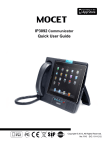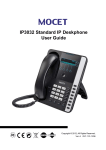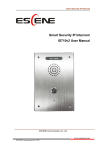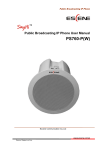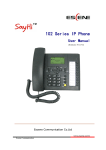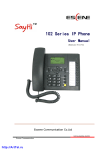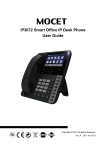Download IP Commander for iOS VoIP User Guide
Transcript
IP Commander for iOS VoIP User Guide Copyright © 2012, All Rights Reserved. Ver: R06 D/C: 101-1212 IP Commander for iOS VoIP User Guide FCC Statement This equipment generates, uses and can radiate radio frequency energy and, if not installed and used in accordance with the instructions in this manual, may cause interference to radio communications. This equipment as been tested and found to comply with the limits for a Class B computing device pursuant to Subpart J of Part 15 of FCC rules, which are designed to provide reasonable protection against radio interference when operated in a commercial environment. Operation of this equipment in a residential area is likely to cause interference, in which case the user, at is own expense, will be required to take whatever measures are necessary to correct the interface. CE Declaration of Conformity This equipment complies with the requirements relating to electromagnetic compatibility, EN55022 class B for ITE and EN 50082-1. This meets the essential protection requirements of the European Council Directive 89/336/EEC on the approximation of the laws of the Member States relating to electromagnetic compatibility. Environment The phone you have purchased, as well as any used batteries must not be disposed of with household waste. You should return these to your distributor if they are to replaced or dispose of them in an approved recycling center. Trademarks iPad™, iPod™, iPhone™, iPad2™, the new iPad™, iTunes™, iOS™, Safari™, AirplayTM and Facetime™ are registered trademarks of Apple Inc., USA. All other company, brand and product names, like Metaswitch™, Broadsoft™, Freeswitch™ and Asterisk™ are registered trademarks of their respective owners. WARNING! 1. Read these installation instructions carefully before connecting the IP phone to its power 2. To reduce the risk of electric shock, do not remove the cover from the IP phone or attempt 3. 4. 5. 6. 7. 8. 9. 10. 11. 12. 13. to dismantle it. Opening or removing covers may expose you to dangerous voltage levels. Equally, incorrect reassembly could cause electric shock on re-use of the appliance. Do not expose the IP Phone to Fire, direct sunlight or excessive heat. Do not expose the IP Phone to rain or moisture and do not allow it to come into contact with water. Do not install the IP phone in an environment likely to present a THREAT OF IMPACT. You may clean the IP phone using a fine damp cloth. Never use solvents (such as trichloroethylene or acetone), which may damage the phone’s plastic surface and LCD screen. Never spray the phone with any cleaning product whatsoever. Take care not to scratch the LCD screen. The IP phone is designed to work in temperatures from 5oC to 40oC. The IP phone must be installed at least 1 meter from radio frequency equipment, such as TVs, radios, hi-fi or video equipment (which radiate electromagnetic fields). Do not connect the LAN/PC port to any network other than an Ethernet network. Do not attempt to upgrade your IP phone in an unstable power environment. This could cause unexpected issues. Do not work on the system or connect or disconnect cables during lightning storms. Children don't recognize the risks of electrical appliances. Therefore use or keep the phone only under supervision of adults or out of the reach from children. 14. No repair can be performed by the end user, if you experience trouble with this equipment, for repair or warranty information, please contact your supplier. Page 2 IP Commander for iOS VoIP User Guide Table of Content 1. INTRODUCTION ........................................................................................................................................................ 4 2. GETTING STARTED.................................................................................................................................................. 4 2.1 TUNING ON THE COMMUNICATOR AND CONNECTING YOUR IPAD ............................................................................ 4 2.2 SOFTWARE INSTALLATION ........................................................................................................................................ 5 2.3 RUNNING THE IP COMMANDER APP.......................................................................................................................... 5 2.4 APPEARANCE & FUNCTION DESCRIPTION ................................................................................................................. 7 2.4.1 Command Menu ............................................................................................................................................... 7 2.4.2 Hot Key Definition ........................................................................................................................................... 9 2.4.3 Screen Icons ................................................................................................................................................... 11 3. BASIC SETTING ....................................................................................................................................................... 12 3.1 NETWORK SETTING................................................................................................................................................. 12 3.2 LINE SETTING ......................................................................................................................................................... 13 3.3 PHONE SETTING ...................................................................................................................................................... 13 3.3.1 Volume Setting ............................................................................................................................................... 13 3.3.2 Call Features.................................................................................................................................................. 14 3.3.3 Hotline Setting................................................................................................................................................ 15 4. BASIC CALL FEATURES........................................................................................................................................ 16 4.1 PLACING A CALL..................................................................................................................................................... 16 4.2 ANSWERING A CALL ............................................................................................................................................... 17 4.3 REJECTING A CALL ................................................................................................................................................. 17 4.4 ENDING/HOLDING/RESUMING A CALL .................................................................................................................... 18 4.5 MUTE AND UN-MUTE A CALL ................................................................................................................................. 18 4.6 REDIALING A NUMBER ............................................................................................................................................ 18 4.7 SETTING UP A CONFERENCE CALL .......................................................................................................................... 18 4.8 TRANSFERRING A CALL .......................................................................................................................................... 19 4.8.1 Blind Transfer ................................................................................................................................................ 19 4.8.2 Attended Transfer........................................................................................................................................... 20 4.9 FORWARDING A CALL ............................................................................................................................................. 20 5. USING ADVANCED FEATURES............................................................................................................................ 21 Page 3 IP Commander for iOS VoIP User Guide 1. Introduction This book is for VoIP user only. If you only use the iPad’s App, do not use IP Communicator’s VoIP function, you don’t need to read this book, please just refer to another quick guide: IP3092 Communicator Quick User Guide. IP Commander, an iPad app, can be installed to enable, configure and operate the embedded VoIP engine of the Communicator. Overall, the seamless combination of IP Commander with Communicator make an top-high end, powerful but easy-to-use desktop VoIP Phone when they are connected to ISP/ITSP’s SIP server or office’s IP PBXs. Before enabling the VoIP phone feature for the Communicator, please read this user guide carefully to understand the basic installation and operation of IP Commander. 2. Getting Started At first time when you unpack the IP3092 Communicator package, please follow the following steps to power on the machine, install IP Commander and start up the VoIP function in your IP3092 Communicator. 2.1 Tuning on the Communicator and Connecting Your iPad When you power on the Communicator, please follow the steps to connect your iPad properly: Step 1. Following the hardware install section of IP3092 Communicator Quick User Guide, connect all Ethernet cables and power adaptors properly; Step 2. Then power on the Communicator, but do not plug your iPad ; Step 3. Wait for the completion of Communicator power-on process. It will take around just under two minutes. The blue message waiting indicator (MWI) LED on the top of the Communicator will be steady on during the booting period. When the LED goes off,, the Communicator is ready for use. Note: For iPad 1 user, please remove the add-on tray before inserting the iPad 1 to the Communicator Page 4 IP Commander for iOS VoIP User Guide 2.2 Software Installation After the Communicator has booted up successfully, you may insert your iPad into the Communicator. Then the Communicator will scan the iPad to determine whether it has been connected to the Communicator before and whether it has the Commander app installed. If this is the first time you connect your iPad to the Communicator (have no IP Commander app in iPad), a dialog box will display, saying “This accessory requires an application you do not have” and “Would you like to install it from App store?” Please press the “Yes” button, the iPad will take you to the app store to download the IP Commander app and then you can install it in your iPad. If more than one iPad is required with this Communicator, the process will be repeated for each new iPad connected. 2.3 Running the IP Commander App Once the IP Commander app is installed on you IPad, you can launch it by clicking on its icon . When the IP Commander launches it will displays messages showing the synchronization progress of the app with the Communicator. This process takes around 30 seconds. During that time the pre-configured data in Communicator will be transferred to IP Commander through iPad’s 30-pin connector. After the IP Commander synchronization process is completed, the default main menu of IP Commander will be displayed as follows: Settings To use the VoIP feature of the Communicator and Commander, you should ask your administrator or service provider to help configure the SIP account or provide you with the necessary account information. These vary quite a bit from service provider to service provider so be sure to request enough help to configure the Communicator properly. Page 5 IP Commander for iOS VoIP User Guide Then you can configure the rest of the user level settings. For detailed explanations of the network and line settings, please refer to Chapter 3 – Basic Network Settings. Audio System Control From the Commander main menu, tough the Audio System Control tab, you will find there are two configurable functions: 1. Commander Enable Control 2. Audio System Control By default, the speakerphone, handset and headset of the Communicator work with iPad apps like Skype, FaceTime, Hookflash and others without any configuration. To use the built-in VoIP feature of the Communicator, you have to switch the audio system control for IP Commander and switch the priority of the audio from iPad to Commander. When the Commander app is enabled, the Communicator’s VoIP phone will share the audio system with iPad Apps. To determine whether the VoIP phone or the iPad app has priority for audio control, a privilege setting can be configured for each. Audio System Control Privilege By default, the audio system (including Speakerphone, Handset, and Headset of the Communicator) is set to prioritize iPad apps so that user can use Skype, FaceTime, Hookflash or other apps or play music or movies without changing any settings. Page 6 IP Commander for iOS VoIP User Guide However, if the “Audio Control Switch” is set to “Commander” (see the figure above), VoIP calls will be prioritized over any iPad app, or iPad audio or video, and any incoming VoIP call will ring the Communicator and the conversation will occupy the audio system until the call is ended. Conversely, if the priority is set to “iPad App”, the incoming VoIP call won’t ring the user but will flash the “HOME” key LED to indicate the call, and the user can pickup the call. Switch “Audio System Control” privilege to Commander 2.4 Appearance & Function Description When the Commander app runs, you can see the Commander screen layout as follows: 1. Menu control: Phone function is the default page. 2. Line/Call display area for phone operation. 3. Phone Status icons display area. 4. Dial pad 12 keys. 5. Fixed Function keys for general call control. 6. Programmable keys for different function setting 7. Sub Commands of Menu. 2.4.1 Command Menu The IP Commander V1.0 supports the following commands. You may access the commands from Menu Control area: Page 7 IP Commander for iOS VoIP User Guide Phone Press the “Phone” function to operate the phone and make/receive the phone calls. Press to view and sort the contacts in iPad. Contacts To add or edit the native contacts, please refer to Apple’s app which can do these functions on Contacts. Speed Dial Press to see speed dial settings and avatars. Call Logs Press to see list of Missed, Answered and Dialed calls. Settings Press to configure user or administrator settings. Information Press to display an overview of how of the Communicator is configured. Audio System Control Press to prioritize the audio system for iPad Apps or Communicator VoIP. Menu Page 8 IP Commander for iOS VoIP User Guide 2.4.2 Hot Key Definition Communicator Keys – The Hot Key in IP3092 docking base Before insert the iPad to the Communicator, please see if you need the add-on tray for iPad2 or the new iPad or not. The figure below shows the Add-on Tray can be removed or slided in easily. Key Hotline Home Speakerphone Mute Headset Description Press this key to make an emergency call whether the iPad is attached or not. A red LED is used to indicate its status, this feature requires a VoIP service subscription. Press this key to bring IP Commander app immediately to the foreground. A blue LED is used to indicate its status Press this key to enable or disable the Speakerphone; a blue LED is used to indicate status Press this key to mute or un-mute a call (the other party will not be able to hear you). Press this key to enable or disable the Headset feature. does not enable or disable the 3.5mm port or Bluetooth connection. Page 9 It IP Commander for iOS VoIP User Guide Volume Rocker Volume control keys to adjust volume of Handset Receiver, Handset DTMF output, Handset Ring output, Headset Receiver, Headset DTMF output, Headset Ring output, Speakerphone output, Speakerphone DTMF output and Speakerphone Ring output IP Commander Keys and Buttons Key Description Use the keypad to dial the phone number or SIP URL. The LCD window displays the number or URL you enter. See screen below Note: You may use the “BkSp” soft-key to delete the last digit. Numeric keypad This button is reserved for future use. Voice Mail Press the Redial key on iPad, the last dialed number will be automatically redialed. Last number redial Press the Mute key on the Commander to mute or un-mute VoIP phone call. Mute/Un-mute Press the Speaker key to switch VoIP call to Speakerphone Speaker Press the Headset key to switch VoIP call to Headset Headset Hold Press the Hold key on the Commander and the current call will be placed on hold. The user can dial a second number on the same line (SIP account). Press the Transfer key to transfer a call to another IP phone Transfer Conference Press the Conference key to place multiple calls on the phone into a conference on the phone. For current IP Commander, it supports up to 3 callers joined in a conference call. Programmable keys Press a Programmable key to execute it’s stored action; the keys can be programmed from both the Commander app and the web interface of the Communicator. The programmable functions include speed dial, BLF, fixed feature, and abbreviated codes. Page 10 IP Commander for iOS VoIP User Guide 2.4.3 Screen Icons The following tables describe the icon definition that may display on the IP Commander screen Phone Status Icons Icon Description The phone is in “Auto Answer” mode The phone is in “Do Not Disturb” mode New Instant Message(s) received on the phone Network connected Network disconnected The Communicator is locked Incoming call(s) missed Line Status Icons Icon Description Line registration to SIP server OK and in idle state Line registration failed Ringing back from the call party, waiting for the call party to pick up the call The active call is in talking state Call on hold An incoming call is ringing In 3-way Conference call Forward the call to another IP Phone Line is enabled “SIP” or “SRTP” Security Line is enabled both “SIP” and “SRTP” Securities Page 11 IP Commander for iOS VoIP User Guide 3. Basic Setting To enable the VoIP Phone function, you need to subscribe to a service or have your Communicator configured to use your company’s IP PBX. This chapter will guide you through the basic configuration for the network setting and SIP account setting for Commander on your Communicator. Before beginning this part of the configuration, you must connect your Communicator to a local area network (LAN) over Ethernet, which will allow the Communicator connect to a local or remote server SIP server. Please refer to IP3092 Communicator Quick User Guide for establishing the Ethernet connection. 3.1 Network Setting To configure the network type as Static IP or DHCP 1. Select “Settings” command from the main menu 2. Select “ Administrator Settings” from the sub-command area 3. IP Commander will ask you to input Admin Password. password is “1234”. The default admin 4. Enter the password and “Confirm” 5. Select “Network Settings” from the sub-command area 6. A Network type selection menu will be displayed as follows. You can specify the network type as DHCP or static IP from this page. Page 12 IP Commander for iOS VoIP User Guide 3.2 Line Setting The IP Commander V1.0 can support one SIP line registration. To configure the SIP line setting, you must get a SIP account from your administrator or ISP/ITSP service provide. To configure the SIP Line setting: 1. Select “Settings” command from the main menu 2. Select “ Administrator Settings” from the sub-command area 3. IP Commander will ask you to input Admin Password. The default admin password is “1234”. 4. Enter the password and “Confirm” 5. Select “Line Settings” from the sub-command area 6. Select “Line 1” (only one line is available in this version) 7. A Line Setting menu is displayed as follows, please fill out your SIP account information here 3.3 Phone Setting IP Commander provide phone setting feature to allow you to customize your own IP Phone functions, such as volume settings for Handset, Headset, and Speaker, programmable keys function definition,… etc. 3.3.1 Volume Setting To adjust the volume control of Handset, Headset, Speaker phone, and Ringer, please follow the steps: Page 13 IP Commander for iOS VoIP User Guide 1. Select “Settings” command from the main menu. 2. Select “Phone Settings” twice from the sub-command area 3. You may adjust the volumes for different voice devices individually from below screen display: 3.3.2 Call Features You may put your IP phone in DND mode, Auto Answer mode, or Call Waiting mode by enabling or disabling the Call Features buttons: 1. 2. 3. 4. Select “Settings” command from the main menu. Select “Phone Settings” from the sub-command area Select “Call Features” from the sub-command area You may enable/disable the DND, Auto Answer, and Call Waiting modes from below screen display: Page 14 IP Commander for iOS VoIP User Guide 3.3.3 Hotline Setting The IP3092 Communication provides 3 hotline numbers, when the user press the “Hotline” hot-key of IP3092 Communication, the Communicator will auto dial out the first hotline number. If no body answers the call until timeout (you can configure the timeout setting from IP3092’s web interface, please refer to the IP3092 User Guide for the configuration of IP3092 web interface), then the Communicator will terminate the first call, and dial the second hotline number out. The round robin will be continued among these 3 hotline numbers until a call is answered, or the hotline call is cancelled. You can configure the 3 hotline number from both Communicator Web Interface or from IP Commander. To configure the hotline numbers from IP Commander: 1. 2. 3. 4. Select “Settings” command from the main menu. Select “Phone Settings” from the sub-command area Select “Hotline” from the sub-command area A Hotline Settings window is displayed, allow you to input the Hotline numbers. You can also fill out the “Hotline Address”, this hotline address will be sent to the hotline party from IP3092 built-in Instant Message Page 15 IP Commander for iOS VoIP User Guide 4. Basic Call Features The IP Commander supports one SIP line with 2 simultaneous calls. However, only one call can be active at one time. The active call is the one you are using to speak or listen to. The inactive calls can be: - On hold - Joined in a conference (with up to 3 callers) - “Incoming call” or “Ringing” This chapter describes the basic operating instructions from IP Commander. 4.1 Placing a Call You can place a call in many ways from the IP Commander: - Using the handset Using the speakerphone Pressing the line key from IP Commander screen Using the headset Dial the number from IP Commander’s numeric keypad No matter which way you are using to dial the party, the dialing screen will display the phone number or SIP URL you dialed. During a call, you can alternate between using the handset or speakerphone modes by pressing the speakerphone key, or picking up the handset while on a speakerphone call. Page 16 IP Commander for iOS VoIP User Guide Operation Description Pick-up the handset or press the speaker key, press the available line or You will hear a dial tone. Line Number Use the keypad to dial the phone number or SIP URL. Making a call The LCD window displays the number or URL you enter. See screen below Note: You may use the “BkSp” soft-key to delete the last digit. On-hook the handset when your conversation is over. 4.2 Answering a Call When a new incoming call on the phone, you can answer the call by: - Using the handset Using the speakerphone Using a headset Pressing “Answer” soft-key on the IP Commander screen Operation Description of Feature(s) or Receiving a call or Pick up the handset or press the speakerphone key or the headset key or press the “Answer” soft-key or upon hearing the phone ringing. Answer key On-hook the handset when your conversation is over. 4.3 Rejecting a Call When there is an incoming call on the phone, you can reject the call. Operation Description Press “Reject” soft-key to reject the call. Rejecting a call Reject After pressing the “Reject” soft-key, the call will be dropped directly. The record will be logged in answered call list. Other call features are not affected by this operation. Page 17 IP Commander for iOS VoIP User Guide 4.4 Ending/Holding/Resuming a Call When a call is in connected state, you can end a call by: - Using the handset Using the speakerphone Using a headset Pressing “Drop” soft-key Operation Description Ending a call or Place the handset back into the cradle, press the speakerphone key or the headset key or press “End” soft-key to end the call. or or End Holding a call Press the hold. Resuming a call Press the key again or “Resume” softkey to place an active call on hold. or Resume key to place an active call on 4.5 Mute and Un-mute a Call While in a conversation, you may mute the microphone by pressing the MUTE ( ) hot-key on the Communicator or pressing the key in the IP Commander screen. The LED of the IP3092 Mute button will become blue. When muted, the other caller will not hear anything from your phone. Pressing the MUTE ( or ) key again to un-mute the phone. 4.6 Redialing a Number To redial the last numbers you dialed, you need just to press the Redial ( from IP Commander screen. ) key 4.7 Setting up a Conference Call The IP Commander can support a 3-party conference call. To set up a conference: 1. Call the first party and Hold the call 2. Press “New Call” soft key from the IP Commander to call another party Page 18 IP Commander for iOS VoIP User Guide 3. Press the Conference ( ) key from the IP Commander to set up a 3-party conference. The conference screen in IP Commander is shown as follows. 4.8 Transferring a Call A call can be transferred in below two ways: Blind Transfer: The call is automatically transferred after you dial the number of the party to whom you want to transfer the call. Attended transfer: The party to whom you want to transfer the call answers their phone before you transfer the call. You can consult with them before completing the transfer. 4.8.1 Blind Transfer To do blind transfer: 1. During an active call, press “New Call” soft-key from IP Commander to call another party. 2. When you hear the ring-back tone, press the Transfer ( Commander to transfer the call. Page 19 ) key from IP IP Commander for iOS VoIP User Guide 4.8.2 Attended Transfer To do Attended transfer: 1. During an active call, press “New Call” soft-key from IP Commander to call another party. 2. Wait for the other party to answer the call. 3. Press the Transfer ( ) key from IP Commander to transfer the call. 4.9 Forwarding a Call You can configure the IP3092 Communicator to forward the incoming call to another party. There are four types of static forwarding: - Unconditional Busy Forward No Answer Forward DND Forward To setup the call forward, please follow the following steps: 1. Select “Settings” command from the main menu. 2. Select “Line Settings (User Level)” from the sub-command area 3. Select “Line 1” from the sub-command area (only Line 1 is available for IP Commander V1.0) 4. Select Call Forward from the sub-command area 5. The following table will be displayed to setup the call forward function and forward number. Page 20 IP Commander for iOS VoIP User Guide 5. Using Advanced Features The Communicator provides more advanced phone features that can be configured on the Communicator app interface. These advanced features can be configured from the Communicator’s Web page. For more detailed information about how to configure the advanced settings, please refer to IP3092 Communicator User Guide and IP3092 Communicator Administrator Guide. However, IP Commander, does provide access to the web interface to configure the Communicator’s advanced features. To access the Communicator’s web interface, your iPad and Communicator must be on the same network and they must be connected properly. Please contact your system administrator or service provider for assistance if you encounter any difficulty. To access the Communicator web interface from Commander: 1. Select “Settings” command from the main menu. 2. Select “Web interface setting” from the sub-command area 3. A dialog box will pop up, to ask you to input authentication username and password. The default username is “admin” and the default Password is “1234” 4. After the username/password is authenticated, the web page will be displayed in IP Commander’s screen Page 21





















